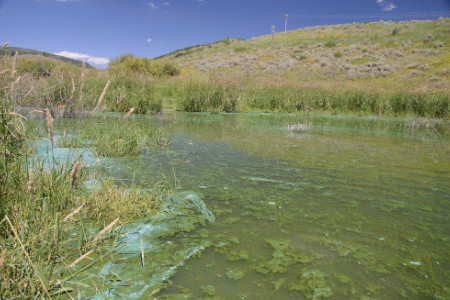Clean water nutrients
Colorado is working to limit nutrients in state waters. Excessive loading of such nutrients can harm aquatic life and lead to the development of toxic algae or harmful algae blooms, called cyanobacteria or cyanoHABs.
Current Division Nutrients Work
- Issuing permits with limits on phosphorus and nitrogen from large wastewater treatment plants and some industrial facilities under Regulation #85 and Regulation 31. More information on which facilities these limits apply to can be found on the Division’s nutrient permitting page.
- Issuing permits that implement phosphorus control regulations (like Cherry Creek Regulation 72) and nutrient-related Total Maximum Daily Loads (TMDLs) , like the Barr-Milton TMDL.
- Providing financial assistance to permittees for nutrients treatment and plant upgrades. More information can be found on the Division’s grants and loans page.
- Working with stakeholders on the development of standards for total nitrogen and total phosphorus for lakes and reservoirs. A rulemaking hearing is scheduled for this work in November 2022. Materials and ways to engage in this work can be found on the Division's 10-Year Roadmap page.
- Working with stakeholders to engage in nonpoint source reductions of nutrients through implementation of best management practices, information and education activities, monitoring and evaluating nonpoint source to point source trade proposals. Progress made through the voluntary provisions of Regulation 85 will be presented to the Water Quality Control Commission in November 2022. Materials and ways to engage in this work can be found on the Division's 10-Year Roadmap page and at npscolorado.com.
- Obtaining nutrient monitoring information from point source dischargers and surface waters. More information can be found on the Division’s nutrient monitoring page.
- Working with dischargers on a program that incentives establishing nutrient controls early, benefitting water quality. More information can be found on the Division’s incentive program page.
Upcoming Nutrients Work
The Water Quality Control Division is working with stakeholders on research in order to propose total nitrogen, total phosphorus, and chlorophyll a water quality standards for all waters to the Water Quality Control Commission in 2027 as part of the Division's 10-Year Roadmap. Please consider participating in the Roadmap’s ongoing stakeholder work around nutrients - we want your input!
- Submission of Reg. 85 nutrient monitoring data: arne.sjodin@state.co.us
- Development of nutrient standards and 10-Year Roadmap: blake.beyea@state.co.us
- Incentive program: bret.icenogle@state.co.us
- Permitting and nutrients: michelle.delaria@state.co.us
